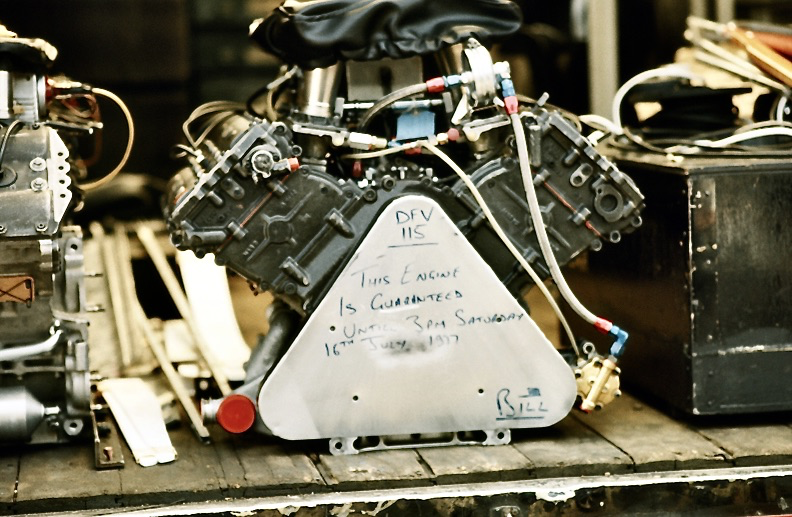Reading Grand Prix reports from the 'kit-car' era of the 1970s, I very frequently read how a DFV, 'brand-new' or 'just back from an overhaul at Cosworth' either blows up within a few laps, or can't even be made to run properly. It got me wondering, what comeback on Cosworth did teams have in those circumstances? Was it a case of 'tough luck', or maybe a discounted or even free replacement, or was it down to individual teams to cut a deal as best they could each time it happened?
Cosworth Warranty?
#1

Posted 08 July 2022 - 11:38
Advertisement
#2

Posted 08 July 2022 - 12:51
Very much down to individual customers/clients and the agreements they had with or through Ford or direct with Cosworth at Northampton. Through the later years service agreements were often made with such approved specialists as Nicholson-McLaren, John Dunn Swindon Racing Engines, John Judd Engine Developments Ltd, etc...
DCN
#3

Posted 08 July 2022 - 13:30
Thanks Doug. I guess that teams well down the pecking order would have had to accept worse consequences than those at the top.
#4

Posted 08 July 2022 - 13:41
I'm sure it would also depend on how closely the team followed Cosworth's installation specifications, particularly on cooling and lubrication.
#5

Posted 08 July 2022 - 13:50
Cosworth adopted a notoriously critical viewpoint where race team customers' engine installation was concerned. Roger is spot on regarding lubrication concerns - 'Cosbodge' would condemn teams' piping and oil tank designs out of hand, and were often regarded as doing so as knee-jerk defence rather than after considered first-hand inspection of the systems involved. "It's plainly your system that's at fault" was a standard reflex response from Northampton.
DCN
#6

Posted 08 July 2022 - 14:33
Cosworth adopted a notoriously critical viewpoint where race team customers' engine installation was concerned. Roger is spot on regarding lubrication concerns - 'Cosbodge' would condemn teams' piping and oil tank designs out of hand, and were often regarded as doing so as knee-jerk defence rather than after considered first-hand inspection of the systems involved. "It's plainly your system that's at fault" was a standard reflex response from Northampton.
DCN
That reminds me of a company I often had to deal with years ago, they were specialist suppliers to the plastics industry. They'd published a handbook years before, a guide to using their products, operatives posing in spotless clothing, everything operating theatre clean and perfect. Their book described recommended techniques for using their products to the best effect, but the it was such a counsel of perfection that no commercial enterprise in the real world could possibly have survived by meeting the standards they insisted upon. If you went to them with a failure or problem of any kind, they could always turn to something, some spurious fault or technique, and deny any responsibility for the results. Whatever you did, you weren't following their laboratory proven methods, but no commercial enterprise could work the way their laboratory staff did and stayed in business. It's only possible to get away with a strategy like that if you have no real competitors, and where were small F1 teams going to go for for a DFV substitute?
#7

Posted 08 July 2022 - 16:42
I'll warrant you that speed equipment is expensive.
#8

Posted 08 July 2022 - 17:31
#9

Posted 08 July 2022 - 17:50
I believe they did - but the teams, of course, considered Cosworth's recommendations ultra-conservative and frequently thought they knew better. In practise, some did.
DCN
#10

Posted 08 July 2022 - 21:09
Edited by Bikr7549, 08 July 2022 - 21:10.
#11

Posted 08 July 2022 - 21:15
Originally posted by Doug Nye
.....In practise, some did.
And in the race?
#12

Posted 09 July 2022 - 04:41
A bloke I knew here in Australia bought a car with a DFV. Before running it he decided that he should consult with the manufacturer about what oil he should run and a few other such questions. So he phoned Cosworth and surprisingly was put through to Keith Duckworth.
He had expected that the oil needed to be something special but the answer he got from Keith was "Do you have Shell X-100 over there? Or Castrol GTX?"
#13

Posted 09 July 2022 - 05:40
And in the race?
Even in Australian English I understand that 'practise' is the verb, 'practice' is the noun. This does not apply to American English but, hey, are we surprised...? ![]()
DCN
#14

Posted 09 July 2022 - 06:28
We tend to think of DFVs as being cheap as chips , and while they were in relative terms, the £7500 they reputedly cost in the early Seventies equates to over ten times that now .Cheap compared to today's ..eer..power unit but not small change . Any customer who'd bought a duff DFV from Cosworth would have had the usual legal remedies . But I also guess that if you'd got judgment against them , Cosworth might be reluctant to sell you another ...
#15

Posted 09 July 2022 - 08:13
Originally posted by Doug Nye
Even in Australian English I understand that 'practise' is the verb, 'practice' is the noun. This does not apply to American English but, hey, are we surprised...?
Sorry, Doug...
Seeing the potential for a double entendré I couldn't resist.
As for US 'English' I am, like most of us, dealing with such issues every day. Yes, in Australia the 's' is appropriate in the verb. But very few are aware of this.
#16

Posted 09 July 2022 - 08:50
'Entendre' doesn't have an acute, or any other accent . Just saying... Even Homer nods and all that .
#17

Posted 09 July 2022 - 09:24
It's the modern world & none of the four engine companies mentioned currently supply F1 engines but at least two of them earn income by supplying engine for the proliferation of supercar/hypercar/track car.
In fact, one hypercar engine I have experience of is based on a F1 engine from the 80s & 90s. Another was based on a racing engine but highly modified.
Such hypercars are bought by the (very rich) man in the street & the whole vehicle requires warrantee.
So the engine suppliers, to protect themselves issue the vehicle designers with spec sheets for their engines.
Those specifications are the 'ideal case' of course.
Such specs will include the required mounting system, oil system with flow & de-aeration figures, fuel system requirements. water system requirements, air intake requirements, electrical & other stuff.
Designing a hypercar to the 'ideal case', is of course , impossible in the confined space of a high performance car.
So begins 'negotiation' over all these things, usually in the 'down' direction. It gives opportunities for inventive design!
At all stages the designer will send the current designs to the engine manufacturer for approval or comment.
In the case of the two manufacturers I have dealt with, they have bent over backwards to help with advice & suggestions, to the extend of manufacturing parts to suit the vehicle design. You would be mad not to consider their suggestions, given the past experience they have.
It benefits the manufacturer also, as they have to dyno test to the warrantee figures for mileage & service.
#19

Posted 09 July 2022 - 10:24
I wish Doug, Ray and John could learn speak English like what l can
I seems I learned it gooder than all of youse
#21

Posted 09 July 2022 - 12:45
Probably the start of practice ...
#22

Posted 09 July 2022 - 13:01
#23

Posted 09 July 2022 - 21:36
Would that have been Bill Lacey ? He was one of the sub contractors who rebuilt DFV's. Initially I believe introduced to Cosworth by John Surtees.
#24

Posted 09 July 2022 - 22:09
Saturday was race day.
Well spotted? You caught me out! ![]()
#25

Posted 10 July 2022 - 06:37
The picture is of Mario Andretti’s race engine for the 1977 British Grand Prix.
The unit is sitting in the very well used Ford D600 truck that Team Lotus converted from their “Flatback”. Note the wooden floor.
This engine is one of three that were provided by Nicholson McLaren Engines to Team Lotus - as you can see the engine was built and guaranteed by “Bill” (Pattision).
The timing of the guarantee is very interesting, as the crankshaft rear-main oil seal failed and Mario retired with no oil pressure 6 laps before the finish, this may, or may not have been after the stated guarantee expiry time.
Interesting times.
Charlie
#26

Posted 10 July 2022 - 08:23
The race started at 3pm, of course. No dummies in the race preparation business... ![]()
#27

Posted 10 July 2022 - 14:19
We tend to think of DFVs as being cheap as chips , and while they were in relative terms, the £7500 they reputedly cost in the early Seventies equates to over ten times that now .Cheap compared to today's ..eer..power unit but not small change . Any customer who'd bought a duff DFV from Cosworth would have had the usual legal remedies . But I also guess that if you'd got judgment against them , Cosworth might be reluctant to sell you another ...
#28

Posted 10 July 2022 - 22:28
From the website:
No warranty: Honda Performance Development parts are sold "as is" without warranty of any kind. Customer understands and agrees that competitive race car driving is an inherently dangerous activity and that it is Customer’s sole responsibility to determine whether the HPD Parts are appropriate ...
#29

Posted 12 July 2022 - 02:14
Yeah that might be a bad example because that particular Mountune listing is for an engine not an 'engine supply'.
Even though you're running the same bits in F4/FRA the service terms may be different.
Something like an F2 engine might be the closest modern example of a DFV. USD80k with one allowed per season. That's a 600+hp turbo V6. They manage to make a season run to the millions with almost no testing or car modifications so...who knows how the game works these days.
#30

Posted 12 July 2022 - 10:01
This engine is one of three that were provided by Nicholson McLaren Engines to Team Lotus - as you can see the engine was built and guaranteed by “Bill” (Pattision).
The timing of the guarantee is very interesting, as the crankshaft rear-main oil seal failed and Mario retired with no oil pressure 6 laps before the finish, this may, or may not have been after the stated guarantee expiry time.
Thanks for that report. I'm familiar with that photo but forgot the context.
Lotus were one of the recipients of Cosworth development engines in 1977. I forget when the programme was put on hold but Lotus had a lot of engine failures that season.
#31

Posted 12 July 2022 - 14:19
Who would expect a serious warranty on something as highly stressed as a racing engine? Not a constructor whose components had been known to fail.
Over rev..me?
#32

Posted 12 July 2022 - 16:59
Edited by Bikr7549, 12 July 2022 - 17:01.
#33

Posted 13 July 2022 - 07:47
I do apologise for this as I am possibly about to expose my extreme ignorance to a group of experts!
If I understand the DFV Serial number sequence correctly engine 115 in that picture was originally built in 1971 and had already won the 1972 Italian Grand Prix and the 1973 Argentine & Spanish Grand Prix’s (according to John Blunsden’s ‘The Power to Win’).
My question is whether DFV’s were like ‘Triggers Broom’ and very little metal from 1971 was sat on the back of that trailer in 1977 or was it essentially the same block just with new heads, crank and ancillaries etc?
Given what I know of their reputation I suspect Cosworth were quite meticulous but then again I’ve learned from this forum that chassis numbers were routinely swapped to fit Carnet's / revenue targets for second hand sales (just kidding).
If the block is original then would it make DFV 928 from Niki Lauda’s 1982 British Grand Prix and John Watson’s 1983 USGP West winning McLaren essentially a 13/14 year old engine (albeit rebuilt dozens of times)?
If so then I find that remarkable, of course I could just be getting numbering systems and myself very confused!
Regards Mike
Edited by blackmme, 13 July 2022 - 07:55.
#34

Posted 13 July 2022 - 08:17
Who would expect a serious warranty on something as highly stressed as a racing engine? Not a constructor whose components had been known to fail.
Over rev..me?
If I'd paid the equivalent of three years' average wages for an engine I might expect some assurance it would not reduce itself to component form the first time I used it. My attitude might explain why my day job was a lawyer , and not North Yorkshire 's answer to Enzo Ferrari.
#35

Posted 13 July 2022 - 09:42
I do apologise for this as I am possibly about to expose my extreme ignorance to a group of experts!
If I understand the DFV Serial number sequence correctly engine 115 in that picture was originally built in 1971 and had already won the 1972 Italian Grand Prix and the 1973 Argentine & Spanish Grand Prix’s (according to John Blunsden’s ‘The Power to Win’).
My question is whether DFV’s were like ‘Triggers Broom’ and very little metal from 1971 was sat on the back of that trailer in 1977 or was it essentially the same block just with new heads, crank and ancillaries etc?
Given what I know of their reputation I suspect Cosworth were quite meticulous but then again I’ve learned from this forum that chassis numbers were routinely swapped to fit Carnet's / revenue targets for second hand sales (just kidding).
If the block is original then would it make DFV 928 from Niki Lauda’s 1982 British Grand Prix and John Watson’s 1983 USGP West winning McLaren essentially a 13/14 year old engine (albeit rebuilt dozens of times)?
If so then I find that remarkable, of course I could just be getting numbering systems and myself very confused!
Regards Mike
Engines are much like complete cars, they get used, broken up and repaired on a regular basis. Parts can be exchanged, and in an engine the block is just another part, if probably the biggest, yet not the most expensive. What constitutes an engine identity (as numbered on the plate) is likely even more difficult to establish than with complete cars. As an analogy, the bodywork of a car, much like the engine block, can be patched up multiple times with parts welded in, or even replaced in its entirety without anyone saying "it's a completely new car". The most expensive bits of an engine are probably found in the timing gear and valve train, dozens of high-precision machined gears and shafts, how often do they get replaced? Unless there's major damage due to warping, not very often I suppose. And if the valve train is damaged, you can be sure that the valves themselves, springs, pistons and rings, maybe even the con-rods need replacing, too. If the crankshaft is gone, the block will also have major damage. At some point, it's going to be cheaper to assemble all the surviving and replaced parts in a new block, with the same number. Still the same engine, even if only a few gears and sprockets remain from the original assembly? If the number says so, it must be...
#36

Posted 13 July 2022 - 09:52
It is hard to think of a component in the DFV which will not suffer from physical wear or stress. The cam covers, for example, are subject to engine and suspension loads. Maybe that V cover at the front of the engine.
DFV blocks which have been subjected to a major blow up have been repaired. A few years ago when demand for a run of new blocks was low, many blow ups were patched.
#37

Posted 13 July 2022 - 12:07
Getting back to the warranty itself, I wouldn't think that's much of an issue in real life. I imagine Cosworth will provide a basic guarantee, but even that will be tied to so many guidelines and provisions* that, in the hectic life of a racing mechanic, it will be neither practical nor economical to follow any of it through, except maybe for very extraordinary failures of kit. In which case it will most likely rely on the goodwill of Cosworth to grant a discount for the next service bill.
* Like, say, Cosworth guarantees blahblah if the following guidelines are strictly followed through: 1) assembly following our detailed manual (especially the instructions on pages 312 to 2598 inclusive, and the clearances detailed in appendices XXXIII to LVII); 2) careful and closely watched warming up procedure for at least 12 hours and 45 minutes; 3) complete tear down and cleansing of all parts following the warm up procedure; 4) repeat assembly as detailed in bullet point one; 5) curing and settling of all parts for 36 hours minimum; etc etc etc and finally 37) a prayer to the racing gods is an essential requirement! ![]()
#38

Posted 14 July 2022 - 14:55
My question is whether DFV’s were like ‘Triggers Broom’ and very little metal from 1971 was sat on the back of that trailer in 1977 or was it essentially the same block just with new heads, crank and ancillaries etc?
Regards Mike
Yes probably the same block :-
DFV's are relatively easy to identify ......

or not ;-)

Speaking of DFV's does anyone know the whereabouts of DFV 906 ? The top photo eliminates the possibility of it being fitted to the restored and bewinged M7C where it was believed to have been residing.
#39

Posted 15 July 2022 - 19:59
If the DFV was anything like the Cosworth YB, then complete engines would be given a unique sequential number, but bare replacement blocks would not be stamped.
Therefore it is possible to retain an original number on an engine even if the block is replaced by simply stamping the new bare block with the original engine number,
Advertisement
#40

Posted 18 July 2022 - 07:23
Bit like a shoe shop - looks at them and says "You have been wearing these!"
As I recall 40 odd years ago the implication very much was the warranty runs out at the factory gate, - if you need a new one you have to pay for it up front .........." Well that's racing !"
#41

Posted 18 July 2022 - 07:31
AS you can see literally only 4 small bolts secured the DFV to the monocoque and all the suspension loads went through that fixing as a fully stressed member - 2 at the very bottom and 2 on end of triangular plates on the cam covers .























